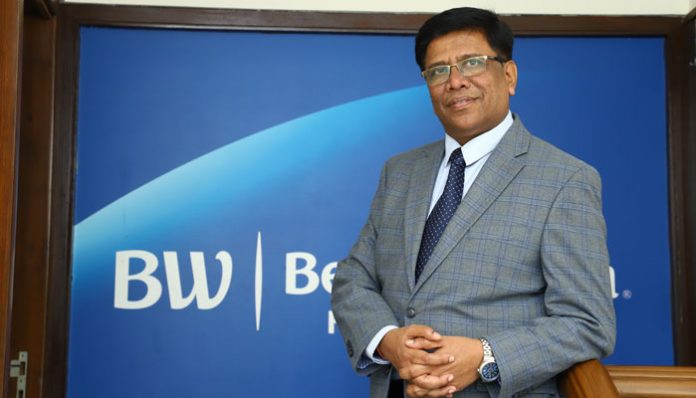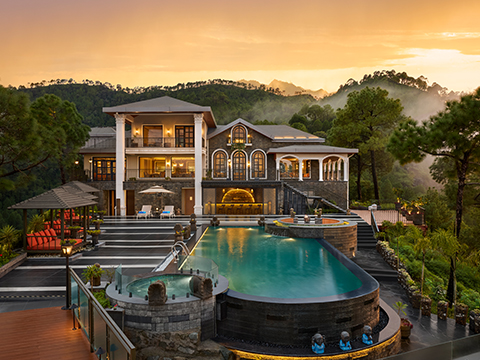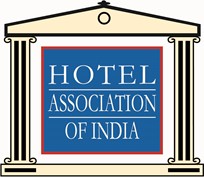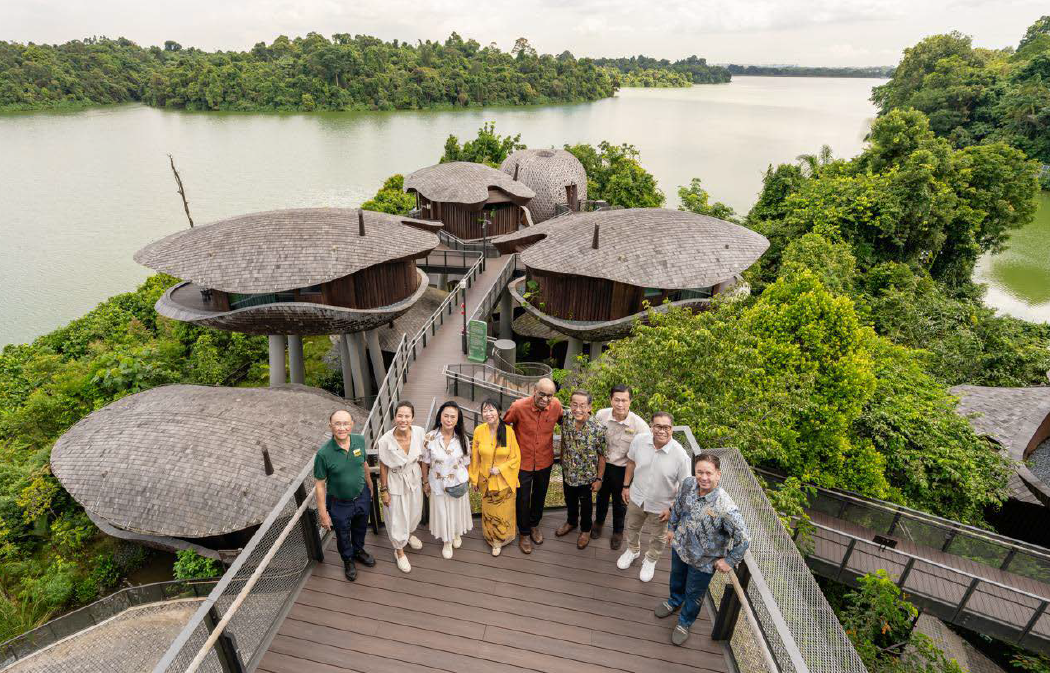With 16 brands and over 4,500 hotels in more than 100 countries, Best Western Hotels & Resorts has been growing exponentially especially in the Indian subcontinent. Atul Jain, Chief Operating Officer, Best Western Hotels & Resorts, India, Bangladesh & Sri Lanka, shares the brand’s plans for the Indian market and what makes BW standout.
Q 1 Tell us a little about Best Western Hotels & Resorts and its evolution over the years.
Founded in 1946, Best Western Hotels & Resorts has since developed and evolved into the only hotel membership-based model in the world, currently comprising the hotel owners in North America. That is the reason the brand is quite sensitive to the needs of the owners in addition to being competitive and performance focused. Starting with the flagship “Best Western” brand, the brand portfolio grew to seven brands by the end of 2014. Beginning 2015, it underwent a brand refresh to broaden the appeal with a contemporary and energetic look, and to distinguish each of its brands and their exceptional offerings by creating more white space between them. Since then, more brands have been added to the portfolio as a response to the evolving trends and business needs of the promoters. Earlier this year, three more brands were added in the brand portfolio with the acquisition of WorldHotels. Today, it has 16 brands and over 4,500 hotels in more than 100 countries.
Q 2 Can you talk about your expansion plans – India, to be specific?
We all know that India has a different kind of hotel market than any other country, and in some ways, it has similar challenges faced by the other developing nations such as China where the hotel industry is still in its formative stages, and doesn’t have the kind of saturation that you find in more mature markets. With the market share of the non-branded hotels exceeding that of the branded hotels, particularly in the midscale segment, there is a lot of opportunity for growth in India since people have become more brand-conscious and are ready to pay for superior quality and experience. Thus, having a good team in place to manage the hotels is crucial to protecting the reputation of the hotel and the brand as well.
Best Western is already one of the most popular international hotel brands in India, and apart from reinforcing its presence, we’re also focussed on opening hotels with other brands in the portfolio to show that we have much more to offer. We have been experiencing a remarkable growth and penetration into diverse markets in India in the past three years, and we hope to gather more pace with the opening of ten more hotels in the next six months that will take our tally to 2,000 operating keys. This would be followed by the opening of over 1,000 keys in the pipeline. The new hotels shall operate under Best Western, Best Western Plus, SureStay Plus and SureStay Hotel by Best Western brands in locations across India. Apart from the new-build hotels, we’re equally focussed on conversion hotels to aid rapid expansion, and we have suitable brands to offer for an easy conversion.
Q 3 How would you define the success of Best Western Hotels & Resorts in India?
‘Your success is our success’ is the mantra we follow in our company. It is a two-way process involving collaborative efforts of all the stake holders and the elements that make everyone proud of being a part of the Best Western family. For us in India, success lies in quality rather than quantity, and the emotional investment. Our brand is dependent on the experiences of our guests staying at hotel. This brand image is really in their minds; not what our marketing message says or what our salesperson maintains. It is through those experiences that we can build a strong brand. The second one is emotional investment for the brand, whether it is by having a strong operational team or sales and marketing activities, are things that make a company successful and well regarded. But you also got to have quality in these elements also. As I mentioned earlier, if you don’t have quality, it can’t grow successfully. Therefore, through our management services and with an experienced team, we think we have a much better chance of succeeding in the longer run.
Q 4 What brands do you have in your portfolio currently?
Best Western, Best Western Plus, and Best Western Premier have been the mainstay brands for a long time, corresponding to the midscale, upper midscale, and upscale segments respectively. SureStay and SureStay Plus by Best Western are the lower midscale and midscale brands for smaller room inventories and are primarily for conversion properties. Vib and Glo brands are upper midscale and midscale boutique brands. While Vib is for primary locations and aimed at tech-savvy, contemporary travellers, Glo is for the secondary market. Executive Residency is an upper midscale brand catering to the extended stay segment for both the business and leisure travellers. Then, there is a bouquet of soft brands comprising SureStay Collection, Best Western Signature Collection, and Best Western Premier Collection, ranging from midscale to luxury segments for quality hotels having a significant brand presence of their own, providing the owners with the advantage of the strong reservation and distribution systems and the quality programme of the brand at the back end. Last year, two more brands were launched, namely Aiden and Sadie, which are high-end boutique lifestyle brands belonging to the upper midscale and upscale positionings.
Q 5 The hospitality landscape is getting overcrowded. How are you geared to deal with these changing business dynamics?
You are right. There has been a tremendous growth in the number of brands in the market, both international and domestic, which is good for the promoters in terms of the wide range of choices that they have and puts them at an advantageous position for negotiating the terms. Further, every hotel chain has multiple brands and new brands keep getting added to the portfolio every year. Here, I would like to say that for a brand to be successful, it needs to have a well-defined selling proposition; about what the brand stands for. So, if you look at all our brands, they are clearly defined in terms of their positioning, development guidelines, and guest facilities and services, aimed at providing a distinct experience to the guests. Every hotel brand has its own space in the market. While the dynamics of the business will naturally keep changing, I firmly believe that continually improving the quality of guest service and comfort and maintaining a healthy relationship with the promoter are the constants that’ll help us keep and expand our footprint in the future.
Q 6 What about the growing influence that Online Travel Agency (OTAs) now have on the hospitality business?
Well, at the outset, we must accept the fact that the OTAs are here to stay and exist as a considerable business channel. Hence, in my view, we must work with them at the terms suitable to us, and I think there are certain ways to coexist. Firstly, the brand has to think about not allowing them to cannibalise their business, which means your website, mobile app, and electronic distribution needs to be really strong.
Secondly, your loyalty programme is the best defence against OTAs because they don’t have it. In our case, we have an award-winning website, mobile app, and loyalty programme that keep us in a pretty good shape to defend against the OTAs.
Thirdly, there has to be a focus on the quality of experience you give to the guests at your hotel. Ultimately, what is the one thing a hotel has that the OTAs don’t have? It is the ability to interact with the customers. OTAs can send business to the hotel, but they have no way of interacting with our customers. Therefore, we educate the hotels to provide the superior experience because that is what is going to make people come back.
Lastly, we need to work out the most advantageous commercial terms with the OTAs. It is not just in terms of negotiating lower commissions, but also in aspects like last room availability and the ability to sell number rates through the loyalty programme, etc. that will ensure our brand search terms are protected.
Q 7 How are you leveraging Best Western’s loyalty programme, ‘Best Western Rewards’ to attract and retain customers?
A lot of people make loyalty programmes more complex than necessary. Hoteliers need to understand what the rewarding part about these programmes for guests is. The first should be the ease of redemption, so we lowered the requirements needed to book a hotel room for free through our programme. Secondly, it is about earning opportunity. Hence, we do a lot of promotions that give guests bonus points, so that they can rack up their points faster to redeem them. On the redemption side, we have partnered with many brands, like Shoppers Stop, Amazon, etc. so that our customers do not just get free room nights, but also gift cards.
We have also worked on the back-end recognition system and upgraded our property management system (PMS). It tells our associates if the guest checking in is a diamond or a platinum guest and we accordingly give them a goodie-bag to appreciate their loyalty towards our brand. Right now, the loyalty programme contribution is about 40 percent globally, which is nothing to sneeze at and in India we are getting there. The programme has different maturity in various parts of the world. In North America, we have had it for the longest time, and that is why we have been more successful. However, in India, China, South America, Europe, etc., we are in the process of ramping it up quickly.
Q 8 What’s your take on technology? What role does technology play in improving guests’ experiences?
Technology has played an important role in the transformation of the hospitality industry over the last decade and a half. It has helped in reducing costs, enhance operational efficiency, and improve services and customer experience. Both customers and businesses can benefit from improved communication, reservations, and guest service systems.
Investing in internet, technology and innovations will allow hotel operators to stand out from the competition, fulfill every guest’s expectations, and attract new customers. Online bookings, automated check in and check outs, keyless entry, etc. are few of the technological examples impacting hotel guest experience.
Q 9 Do you see AirBnbs of the world as a threat or an ally?
Well, first, I think if you look at Airbnb, it’s a platform that capitalises on a sharing economy. There are different hosts that use this platform. There are people that might just want to rent out their spare bedroom every now and then. That’s the sharing economy. That’s not what the hotel industry is concerned about. We are more concerned about the commercial operators that are operating full-time. They basically buy apartment buildings and rent them out as hotels. That’s the one thing that we are more concerned about. I want to emphasise that we have nothing against a sharing economy, nothing really against Airbnb per se. It’s the commercial operators that leverage a platform to circumvent all the health and safety protections or the accessibility that the consumers should have. However, Airbnb is taking up a huge share of supply in major markets, which puts pressure on occupancy and, by proxy, room rates. When hotels partner with OTAs it’s a channel shift, that is, you switch from a brand channel to a more expensive OTA channel that you pay a commission on. With Airbnb, it’s a share shift. You lose the business; you no longer have the business. It is a threat that cannot be underestimated.
“Best Western have been experiencing a remarkable growth and penetration into diverse markets in India in the past three years, with the opening of ten more hotels in the next six months that will take our tally to 2,000 operating keys”
Our success in India lies in quality rather than quantity, and the emotional investment. Our brand is dependent on the experiences of our guests staying at hotel and not what our marketing message says or what our salesperson maintains









